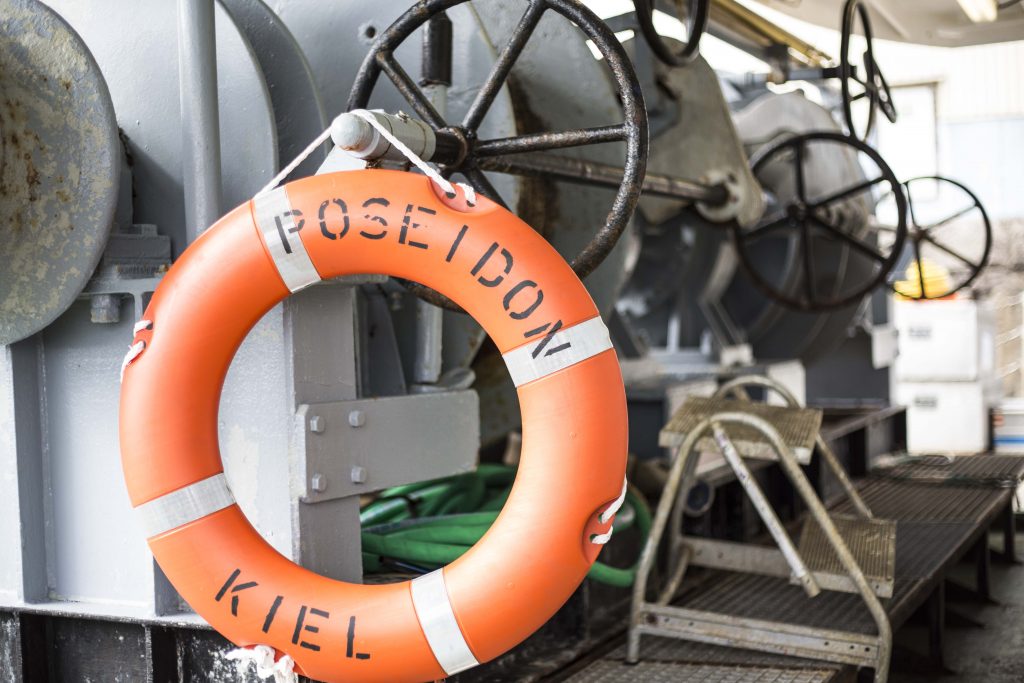Las Palmas. Yesterday we started the setup for the upcoming expedition on board the POSEIDON. Almost all of the equipment arrived with the ship in a container, which had to be emptied upon arrival. With all equipment on deck, the setup in the different labs and on deck could start.
Melf installed a mast on the anchor deck at the front of the ship, with a measuring system for carbon dioxide (CO2) eddy covariance flux measurements. This system measures three dimensional wind speed and the concentration of CO2 in the air. As we are on a ship the measured wind is affected by the movement of the ship. This system is able to provide data of this movement in order to calculate the exact wind speed excluding the movement of the ship.

Melf Paulsen is installing the measuring system for CO2 Eddy Covariance. Melf Paulsen installiert das Messsystem für CO2 Eddy Covariance (Credit: Lisa Hoffmann, CC BY-NC-ND)
Katharina also works with gases. She installed a Mini-QCL-AS (Quantum cascade laser absorption spectrum) system in the wet lab on board of the POSEIDON. This instrument measures different gases in the atmosphere. It is high measurement frequency instrument with a laser and can measure atmospheric gases that occur in low concentrations. Katharina focuses on measurements of carbonyl sulfide (COS).
Damian works in the same lab with Katharina and researches the gases nitrous oxide (N2O), also known as laughing gas or nitrous oxide, carbon monoxide (CO) and CO2. He also works with a laser system to provide high-resolution measurements of these gases in the atmosphere and in the water.
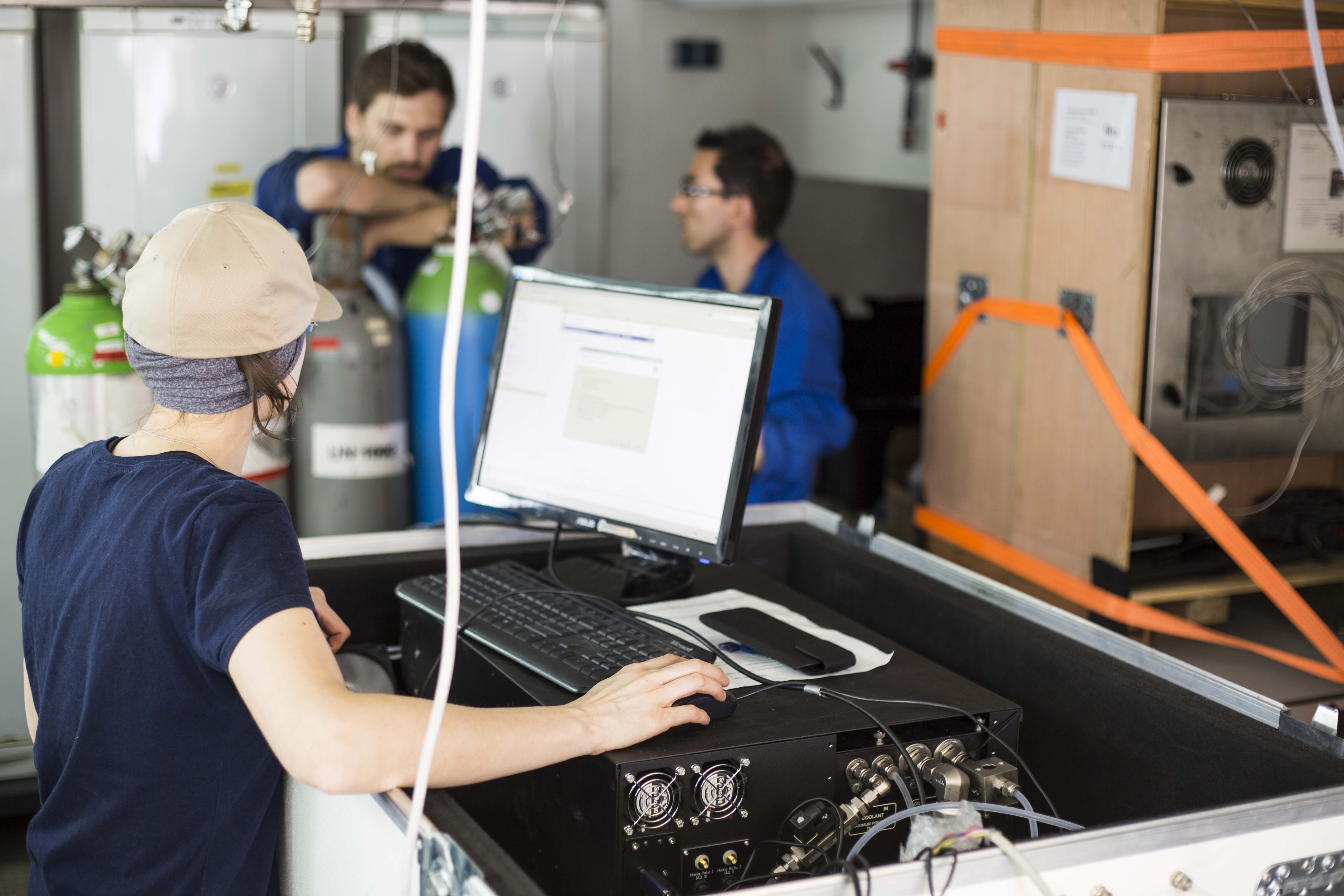
Katharina is working in the chemical lab with the Mini-QCL-AS. Damian is discussing the next steps with Melf. Katharina arbeitet im Chemie Labor am Mini-QKL-AB, während Damian die nächsten Schritte mit Melf bespricht. (Credit: Lisa Hoffmann, CC BY-NC-ND)
Theresa analyses the surface of the ocean. Her work is about the co-occurrence of phytoplankton and surfactants (particles) which accumulate on the surface of the sea. During the cruise, she will take water samples with a special method, which will be analyzed in the GEOMAR labs back in Kiel. She is looking forward to seeing which particles will be found in the surface of the ocean.
More information and a detailed view inside the work of the different scientists and labs will be provided during the research cruise in the following days. Today and on Monday the setup will continue and the first tests of the functionality of the different measurement systems will take place. Tobias, chief scientist of the expedition, is glad that all materials arrived in good condition after sailing through the Bay of Biscay. Together with the other scientists, he is looking forward to set sail and start the expedition to the Mauritanian coast.
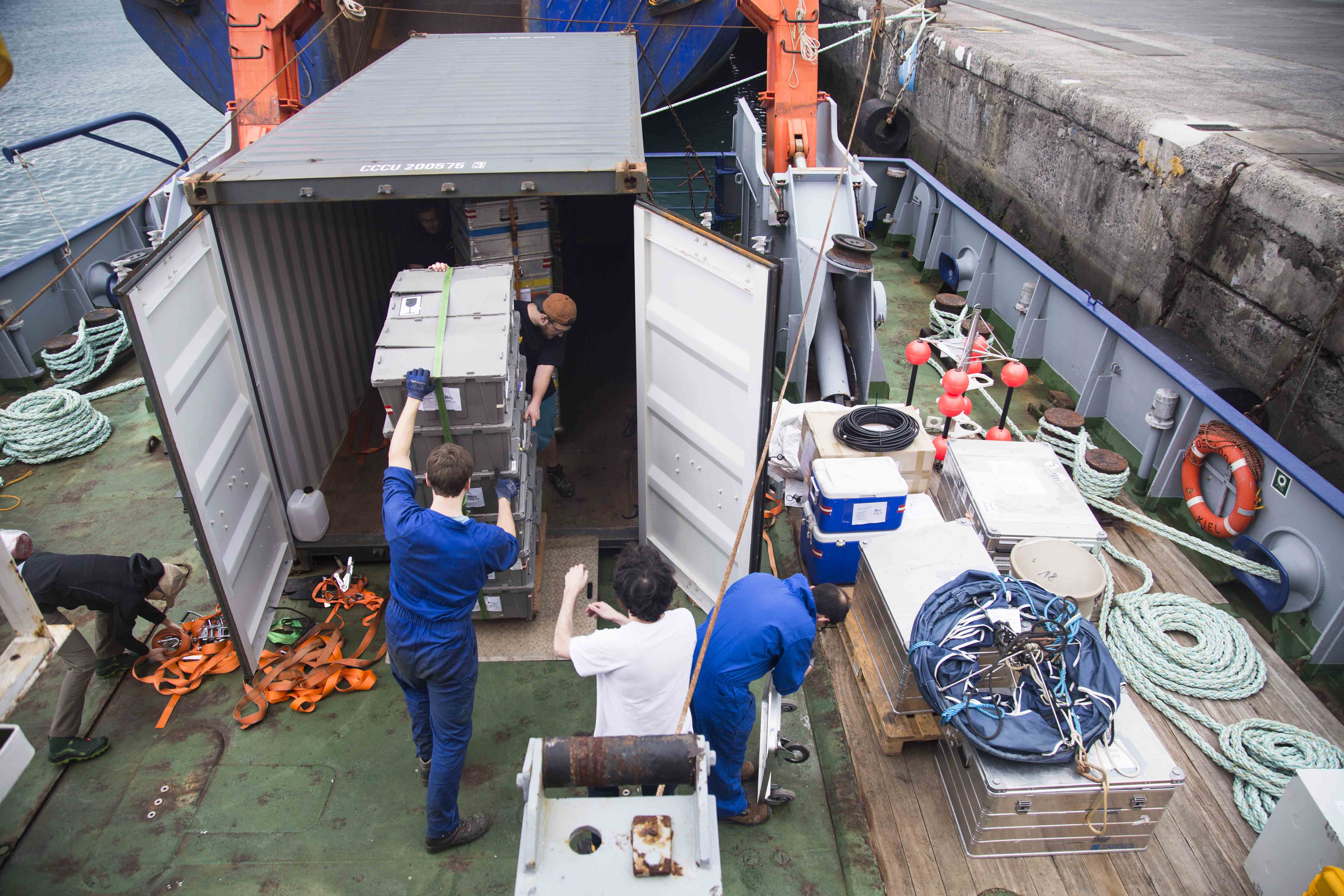
Discharging the container. Everything arrived in a good condition. Der Container wird entladen. Alles ist heil angekommen. (Credit: Lisa Hoffmann, CC BY-NC-ND)
Las Palmas. Gestern ist Aufbau der verschiedensten Messstationen an Bord der POSEIDON für die anstehende Forschungsfahrt gestartet. Fast alle Teile sind mit dem Schiff in einem Container angekommen, sodass dieser zunächst ausgepackt werden musste, bevor mit der Einrichtung der verschiedenen Labore und Messstationen begonnen werden konnte.
Melf beschäftigt sich in seiner Masterarbeit mit dem Gasaustausch zwischen Ozean und Atmosphäre. Dafür installiert er am Bug der POSEIDON eine Mast, an dem sich ein Messsystem für CO2 Eddy Covariance befindet. Luftmasse bewegt sich in Wirbeln, welche Eddies genannt werden. Misst man die Bewegung dieser Eddies und die darin erhaltenen Gaskonzentration lässt sich damit der Austausch zwischen Ozean und Atmosphäre bestimmen. Da auf einem Schiff neben der natürlichen Luftbewegung zusätzlich die Bewegung des Schiffes hinzukommt, muss diese von den tatsächlichen Ergebnissen abgezogen werden, um ein eindeutiges Ergebnis zu erlangen. Das von Melf installierte Messsystem ermöglicht eine solche Messung.
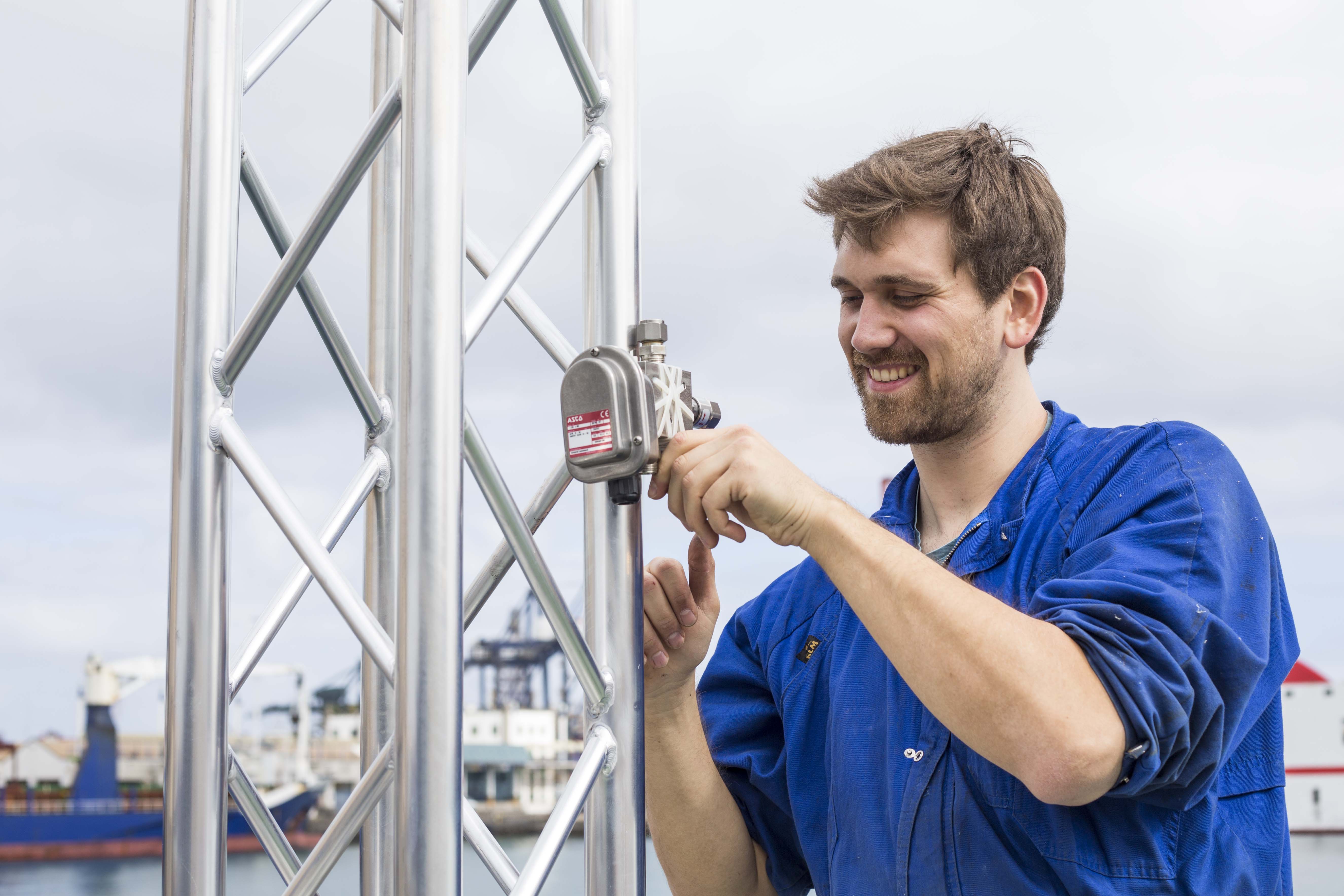
Melf is setting up his equipment at the bow oft he ship. Am Bug installiert Melf seine Messanlagen. (Credit: Lisa Hoffmann, CC BY-NC-ND)
Auch Katharina beschäftigt sich mit Gasen. Im Nass-Labor an Bord der POSEIDON installiert sie ein Mini-QKL-AB (Quantenkaskadenlaser-Aborbtionsspektrumeter). Dieses Gerät misst Gase, wie Spuren- oder Treibhausgase, in der Atmosphäre vorhanden sind. Da es sich um ein Hochfrequenzmessgerät handelt ermöglicht es die Messung von Gasen, die nur in sehr geringen Anteilen in der Luft auftauchen. Carbonsulfid (COS) ist ein solches Gas, das mit Hilfe des im Gerät eingebauten Lasers gemessen werden kann.
Damian arbeitet ebenfalls mit Hilfe eines Lasers. Er beschäftigt sich mit den Gasen N2O, uns auch als Lachgas bekannt, CO (Kohlenmonoxid) und CO2 (Kohlenstoffdioxid). Mit Hilfe des im Gerät eingebauten Lasers kann er hochaufgelöste Messungen von diesen in der Atmosphäre, aber auch im Wasser vorhandenen Gasen anfertigen.
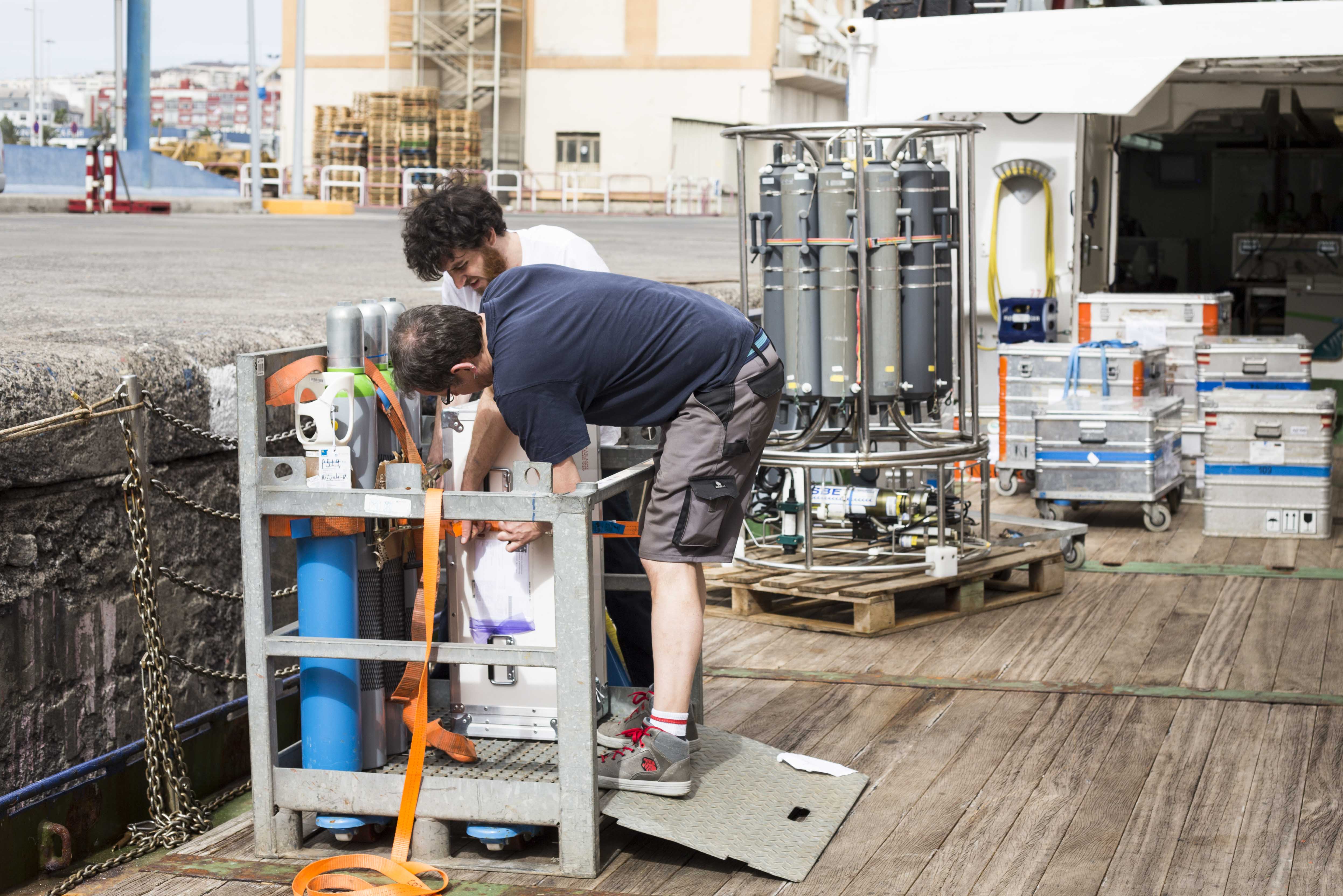
Tobias and Ricardo are unloading gas bottles on deck. Auf dem Deck entladen Tobias und Richardo die Gasflaschen für die Messungen. (Credit: Lisa Hoffmann, CC BY-NC-ND)
Theresa baut im Chemielabor ihre Instrumente auf. Sie wird während der bevorstehenden Forschungsfahrt die Schicht auf der Oberfläche des Ozeans untersuchen. Ihr Thema ist dabei der Zusammenhang von Phytoplankton und sich auf der Oberfläche ansammelten Partikeln, in der Fachsprache auch Surfactants genannt. An Bord wird Theresa Proben nehmen, die sie dann zurück in Kiel in den Laboren des GEOMARs mit Hilfe eines Polarographen untersuchen wird. Sie ist gespannt, welche Partikel sie im Oberflächenwasser finden wird.
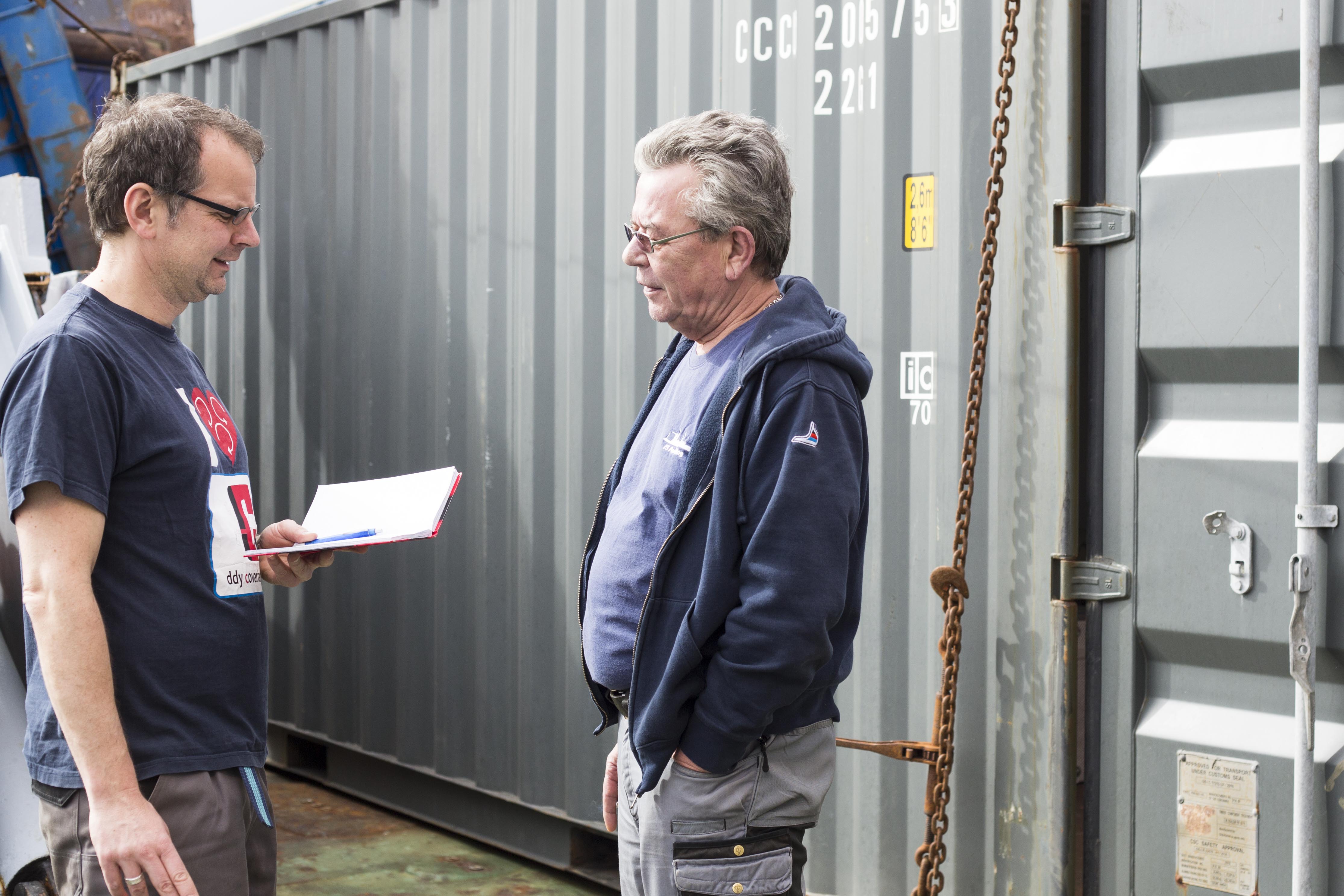
Tobias discusses the next steps with the boatswain Achim. Tobias geht mit dem Bootsmann Achim die folgenden Arbeitsschritte durch. (Credit: Lisa Hoffmann, CC BY-NC-ND)
Detaillierte Informationen über die Forschungsschwerpunkte und tiefere Einblicke in Arbeit in den Laboren und an den verschiedenen Messstationen werden in der kommenden Zeit während der Forschungsfahrt vorgestellt. Am Sonntag und Montag geht der Aufbau weiter und erste Testmessungen werden geplant, um die Funktionalität der verschiedenen Messinstrumente und einen möglichst reibungslosen Ablauf der Forschungsfahrt zu gewährleisten. Tobias, Fahrtleiter dieser Expedition auf der POSEIDON, ist froh, dass alle Instrumente und das gesamte Material die Überfahrt von Kiel nach Las Palmas durch die raue Biskaya heil überstanden haben. Zusammen mit den anderen Wissenschaftlern sieht er dem Start der Expedition mit freudiger Aufregung entgegen.
Text: Lisa Hoffmann
